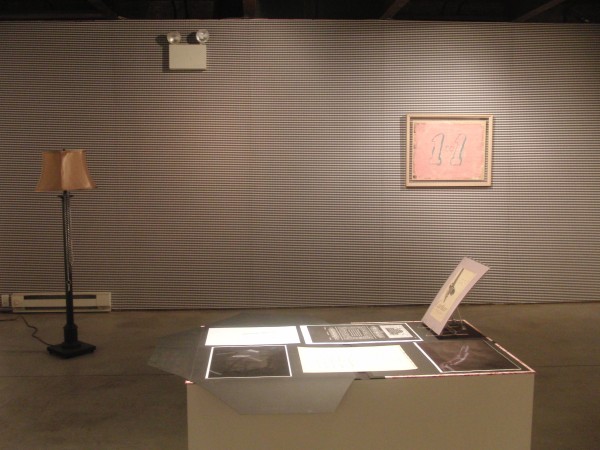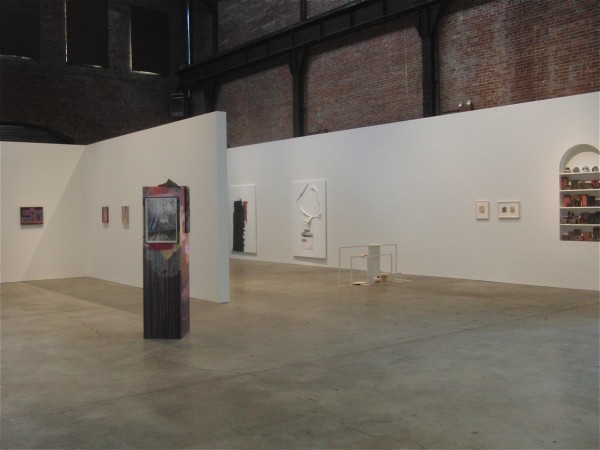
“Novel” examines different modes of storytelling as part of “Time Again” at SculptureCenter (photo by twi-ny/mdr)
SculptureCenter
4419 Purves St.
Thursday – Monday through July 25, suggested donation $5, 11:00 am – 6:00 pm
718-361-1750
www.sculpture-center.org
Playing off of Walter Benjamin’s theory of the vanishing point in the here and now, curator Fionn Meade has put together an intriguing collection of paintings, drawings, sculpture, installation, and video for the two-floor show “Time Again.” On view at Long Island City’s SculptureCenter through July 25, the show consists of works that self-consciously examine and manipulate imagery, representation, gesture, narrative, and the past through repetition and sequencing. In “Image of Absolon to Be Projected Until It Vanishes,” Matthew Buckingham continuously projects a single slide of Christian Gottlieb Vilhelm Bissen’s 1901 statue of Copenhagen founder Bishop Absalon atop a horse; over the course of the exhibition, the heat from the projector will cause the image to fade into nothingness, taking the history it embodies with it. Uli Hohn’s six cast plaster and wood reliefs are each slightly different, creating their own time line that feels like it is still in process. Evoking Andy Warhol’s 1960s Screen Tests, Rosalind Nashashibi’s “This Quality” cuts from a series of shots of a woman staring into the camera to cars covered by fabric on the streets of Cairo; rather than protecting the automobiles from the elements, it appears that the sheets are hiding their past, especially as people walk by. In a separate area, pieces by Sergej Jensen, R. H. Quaytman, Paul Thek, and others make up “Novel,” which provides a unique look at storytelling.
The exhibit kicks into high gear in the basement, where the works are set up amid narrow concrete hallways and passages and in dark rooms. Laure Prouvost’s “It, Heat, Hit” video confronts viewers directly, demanding their attention and that they remember what they see, flash cuts of text and image that fly by in a fury as they tempt and attack all five senses. Rosemarie Trockel’s “Goodbye, Mrs. Mönipaer” consists of longer, calmer shots of a glassed-in bungalow on a beach, water lapping onto the sand as two women, one in a bikini, the other in a bathrobe, each one wearing a mask, are involved in a potential art deal. In “Untitled (David Wojnarowicz Project),” Emily Roysdon re-creates David Wojnarowicz’s “Arthur Rimbaud in New York” series, which comprised photographs of a man, most likely the artist himself, walking the streets of New York wearing a mask that replicated the only known photo of the influential French poet; Roysdon has revisited that idea by taking photos of friends wearing a mask that depicts Wojnarowicz’s visage. In “Berlin Flash Frames,” William E. Jones repurposes a 1961 propaganda film produced by the U.S. Information Agency to question history and memory as the Berlin Wall is constructed and individuals are prepared for relocation. And in “Rabbits,” Aurélien Froment details how to make various knots by using the “rabbit hole” storytelling technique about a rabbit and a snake, neatly tying everything together before taking them apart. The films, most of which are shown using old-fashioned projectors, are the star of the show at the cavernous SculptureCenter, which evokes the past itself, having taken over a former trolley factory, with various mechanical contraptions still visible, creating a kind of palimpsest. SculptureCenter is open on July 4; if you check in on foursquare, you get two-for-one admission and free lemonade. In addition, SculptureCenter will host a pair of “Time Again”-related screenings July 5-6 at 7:00 at Anthology Film Archives, including short works by Joan Jonas, Shahryar Nashat, Ursula Mayer, and exhibition artists Prouvost, Nashabishi, Buckingham, and Jones; Leslie Thornton and Lisa Oppenheim will participate in a special conversation following the July 5 show, with Jones taking part in a Q&A following the July 6 screening.
